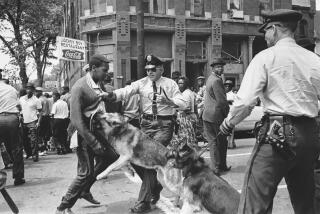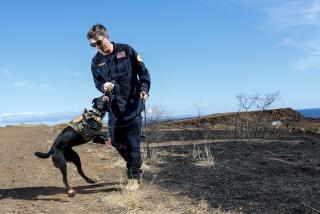Police Officer’s Bloodhounds Are Dogged Duo
- Share via
Ten years ago Janie Walker read a newspaper story about a homicide in Huntington Beach and how police used bloodhounds to track the killer.
“I said to myself that one of these days I’m going to have a bloodhound and use it for law enforcement,” said Walker, 35, a reserve officer with the Costa Mesa Police Department.
Last year she brought two bloodhounds to her Costa Mesa home and is already gaining a reputation for her work with the dogs, especially with Koosa.
The 1 1/2-year-old bloodhound is Matoaka Koosawin, an American Indian name meaning “playful one who hunts on foot.”
“I came up with the idea of using jumbled Indian words from the Cherokee, Chippewa and Hopi tribes to train the dogs.” said Walker, wife of David Walker, a Costa Mesa police sergeant. “I don’t want anyone else talking or giving orders to my dogs.”
Her newest bloodhound is named J.W. Yamaseer Moanahonga, which translates to “Gentle Great Walker.”
She gave her initials to the 1-year-old dog, saying, “I like to be attached to my puppies.” She calls the dog Mo for short.
Both dogs are still in training, although Koosa has worked a few assignments including tracking a missing 6-year-old. “We came within a couple of blocks until the father found him,” she said. “We were on the right track.”
In October, Walker and the dog tracked down a stolen-vehicle suspect who was also an escapee.
“We’re getting to be known,” said Walker, who said the Costa Mesa department is the only police force in Southern California to use bloodhounds.
It takes three years to fully train a bloodhound, working five days a week at first and then three days a week for a couple of hours, said Walker, who was recently named Costa Mesa Reserve Officer of the Year by the department.
“I get a lot of strokes, so the rewards aren’t important to me,” said Walker, an Estancia High School and Golden West College graduate. “I do police work to satisfy me.”
The Costa Mesa Police Department has always been part of her life.
“It’s been like family to me,” she said. “My father was a policeman for Costa Mesa, and I remember going to the police station with him. I liked the atmosphere, the excitement and the people there.”
Walker expresses deep respect for her dogs, who are also companions to her children, and knows what motivates them. “When these dogs work they will track until they physically can’t run any more,” Walker said. “They can go on for miles and days.”
What the dogs need most, she said, “is constant love. They crave love. Tracking people is a game to them, although they are serious about it. At the end they know they are going to get a lot of praise. They get so excited.”
She also raises Dalmatians to show.
There is little free time for Walker, who also rides as an observer in the police helicopter and often works a 40-hour shift, including undercover vice assignments such as posing as a street-walking prostitute.
“I do all this because I love it,” she said.
Texas Instruments has given 40 of its solar-powered calculators to students at Spurgeon Intermediate School in Santa Ana. Now it wants something in return.
The company wants students to give their assessments of the calculators, which work in fractions.
Ana Golan, the school district’s math demonstration teacher who obtained the calculators, says students will be surveyed next year to get their reactions to the product.
Spurgeon is one of 100 schools in 30 states taking part.
Acknowledgments--Christine Riley, a senior at Cornelia Connelly School in Anaheim, was named a winner of the National Council of Teachers of English achievement award in writing. Judges looked for writing that demonstrated effective and imaginative use of the English language to inform and move the reader.
More to Read
Sign up for Essential California
The most important California stories and recommendations in your inbox every morning.
You may occasionally receive promotional content from the Los Angeles Times.













